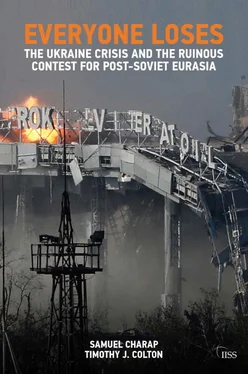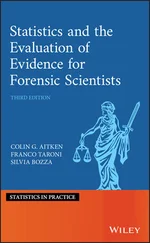Low-grade competition
Yet what typified the Cold Peace was not cooperation but the chilly disinterest insinuated by the catchphrase and the rise of competition in and over the In-Betweens, and to a lesser degree Central Asia. The competition was low-grade and muffled by situational factors, but competition all the same.
A starting point was the new Russia’s avowal of geopolitical supremacy in post-Soviet Eurasia. Contrary to myth, this sense of entitlement was not the invention of Vladimir Putin after 1999. His more forward-thinking predecessor, Boris Yeltsin, laid it out unapologetically in a presidential decree on ‘The Strategic Course of the Russian Federation with Respect to the Member States of the Commonwealth of Independent States’, dated 14 September 1995. The decree is in force to the present day. ‘On the territory of the CIS’, it was affirmed, ‘are concentrated Russia’s most vital interests in the domains of economics, defence, security, and defence of [its citizens’] rights’. Russia was envisaged as a ‘leading force in forming a new system of international… relations in the post-USSR space’, and integral to this effort as acting ‘to foster integrative processes in the CIS’. In a sharply worded section on security, Yeltsin stipulated that Russian policy ‘obtain from the CIS states performance of their obligations to desist from alliances and blocs directed against any of these states’. NATO should stay at arm’s length, and the CIS countries should be in unison with Russia in waving a ‘No Trespassing!’ sign at interlopers. The decree allowed for cooperation with international organisations like the UN and the OSCE in regulating intra-regional conflicts, but underscored the need ‘to get them to understand that this region is first of all Russia’s zone of influence ’. [52] From the full text in Russian at ‘Strategicheskii kurs Rossii s gosudarstvami – uchastnikami Sodruzhestva Nezavisimykh Gosudarstv’, 14 September 1995, http://www.mid.ru/foreign_policy/official_documents/-/asset_publisher/CptICkB6BZ29/content/id/427752 (italics added). President Putin in 2005 nullified two minor articles of the decree, leaving the rest of it intact.
The text on the face of it was a classic example of zero-sum geopolitics.
Russian attitudes towards the former Soviet republics were in flux in the 1990s. It was a decade of rampant uncertainty for all these countries, both domestically and in terms of their foreign relations. For the greenhorn Russian elite, many of whom had been in the Soviet, ‘all-union’, institutions just a few years earlier, acceptance of the other progeny of the USSR as fully sovereign countries did not come easily. For example, Vladimir Lukin, Moscow’s ambassador to Washington, blithely told Talbott in 1993 that relations between Russia and Ukraine were to be ‘identical to those between New York and New Jersey’. [53] Quoted in Talbott, Russia Hand , p. 80.
Lukin was something of a liberal on the Russian political spectrum; Russian nationalists, who were well represented in parliament, were more menacing. One lawmaker warned in October 1992 against ‘absolutising’ the new borders dividing the former republics, since they were ‘artificial’ and ‘arbitrary’. [54] Yevgeny Ambartsumov, quoted in Emil Pain, ‘Mezhnatsional’nye konflikty v politicheskoi igre’, Nezavisimaya gazeta , 10 July 1992.
Even Yeltsin, when he needed to protect his right flank, would indulge; for example, in March 1993 he called for ‘international organisations’ to grant Russia ‘special authority as guarantor of peace and stability on the territory of the former USSR’. [55] Quoted in ‘Chto bylo na nedele’, Kommersant , 6 March 1993.
The statement was not backed up by action, but it did inflame sensibilities across the region, eliciting angry retorts from several of the neighbours.
To have its way in post-Soviet Eurasia, the Russian Federation relied on a range of tools. It meddled persistently, though without a master plan, in the internal politics of the successor states, providing moral and media support, and from time to time funding, for groups receptive to Russian policy. In Ukraine, Russia threw its weight behind Yuri Meshkov, the head of the Crimean provincial government, who was a proponent of holding a referendum on secession of the peninsula from the rest of the country. When the national parliament dismissed him in 1995, he was granted asylum in Moscow. In most of the In-Betweens, Moscow’s agencies maintained relations with representatives of diaspora Russian communities. Even moderates like Kozyrev spoke out for defence of the rights of Russians and Russian speakers in the former republics and their ‘voluntary reintegration’ with the Russian Federation. [56] For an early assessment, see Fiona Hill and Pamela Jewett, ‘“Back in the USSR”: Russia’s Intervention in the Internal Affairs of the Former Soviet Republics and the Implications for United States Policy Toward Russia’, Strengthening Democratic Institutions Project, John F. Kennedy School of Government, Harvard University, January 1994, http://belfercenter.hks.harvard.edu/files/Back%20in%20the%20USSR%201994.pdf .
A nationalist faction around Yuri Luzhkov, mayor of Moscow, were for a more venturesome policy and took a special interest in Crimea.
Russia kept military forces stationed in all of the In-Betweens and, for some time, in the Central Asian republics. Some of these garrisons resulted from its role as pacifier and mediator in the range of ethnic and political conflicts that broke out as the Soviet Union splintered. In Moldova, wedged between Ukraine and Romania, the Soviet and then Russian 14th Army defended the breakaway Transnistria in its conflict with Chisinau in 1990–92. Although unrecognised by any member of the United Nations, Transnistria has had self-rule ever since, and Russian peacekeepers and remnants of the 14th Army are still in place. In Georgia, Moscow brokered an end to two ethno-national wars between the Georgians and the South Ossetians (1991–92) and Abkhaz (1992–94), groups that had eponymous semi-autonomous provinces within the Georgian republic of the USSR. In Abkhazia, Russia’s ‘policy of divide and rule included military support to both sides in the conflict, which, over the course of the conflict, increasingly favored the [Abkhaz]’, ministering to them with weapons, training and the odd airstrike on their Georgian adversaries. [57] Christoph Zürcher, The Post-Soviet Wars: Rebellion, Ethnic Conflict, and Nationhood in the Caucasus (New York: New York University Press, 2007), p. 141.
The ceasefire agreements created Russian-dominated peacekeeping forces in both areas, along with diminutive international observer missions. Russia kept its army out of Nagorno-Karabakh, the breakaway province of Azerbaijan populated by ethnic Armenians that was the locus of a six-year-long succession of clashes, but it at one and the same time brokered a 1994 armistice in the fighting there, manned its Gyumri base in Armenia (thus warding off intervention by the Turks, ethnic cousins of the Azeris), promised to safeguard Yerevan’s security and happily peddled arms all around. Moscow also intervened to put an end to the civil war of 1992–97 in Tajikistan, which had left more than 50,000 people dead.
In the early 1990s, Moscow’s involvement in these crises was necessary (no other power was prepared to step in) and productive, in that it put a stop to bloodshed. Despite some misgivings in Washington, the US was generally empathetic; Clinton said in Moscow in January 1994, ‘I think there will be times when you will be involved… in some of these areas near you, just like the United States has been involved in the last several years in Panama and Grenada near our area.’ [58] ‘Remarks in a Town Meeting with Russian Citizens in Moscow’, 14 January 1994, https://www.gpo.gov/fdsys/pkg/WCPD-1994-01-24/pdf/WCPD-1994-01-24-Pg67.pdf .
The problems emerged after the guns had been silenced. With the exception of Tajikistan, all of the post-conflict arrangements Moscow brokered became mired in stalemate, earning these conflicts the ‘frozen’ label. The lack of political settlements provided a convenient rationalisation for maintaining Russian troops as peacekeepers in Abkhazia, South Ossetia and Transnistria, along with the bases in Armenia and Tajikistan, which the host governments welcomed. And Moscow had direct dealings with both recognised national governments and the separatist enclaves themselves. In Transnistria, South Ossetia and Abkhazia, Russia even began issuing passports to locals. Russian officials were often seconded, so to speak, to the separatist governments.
Читать дальше











